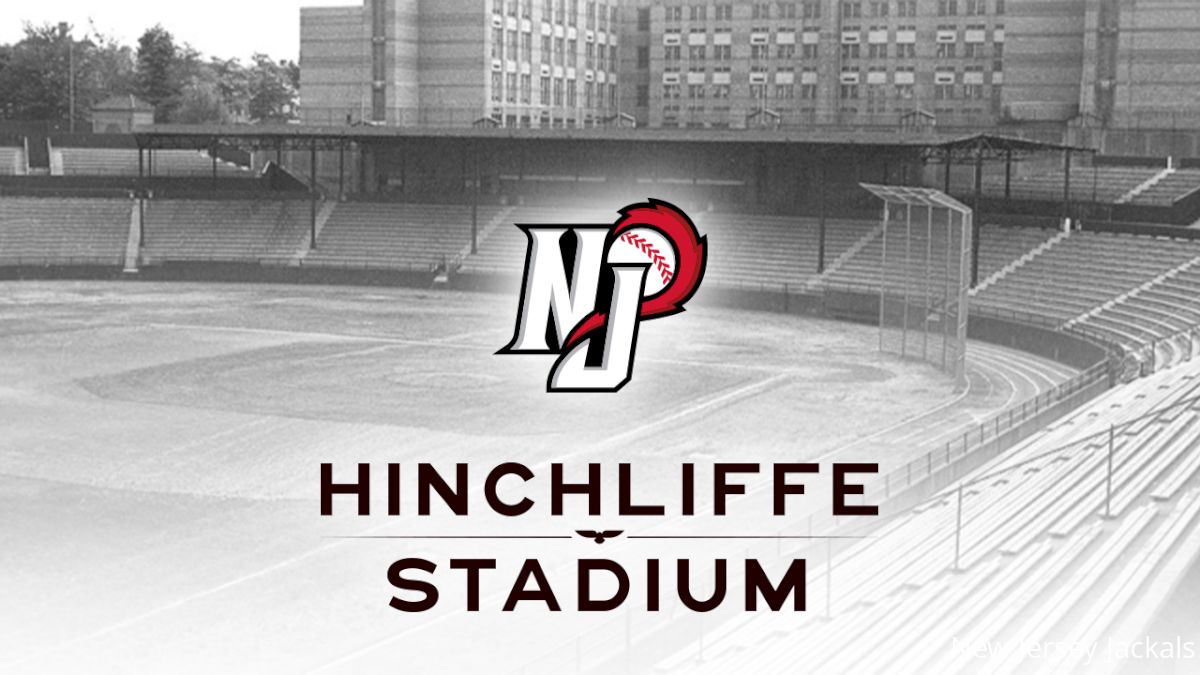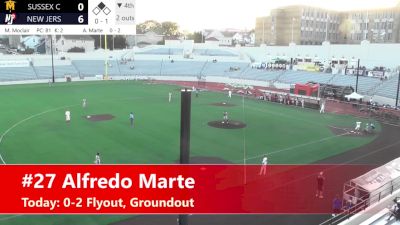New Jersey Jackals Keep Legacy Of Hinchliffe Stadium Alive
New Jersey Jackals Keep Legacy Of Hinchliffe Stadium Alive
The New Jersey Jackals' move to Hinchliffe Stadium in the 2023 Frontier League season keeps alive the Negro League traditions of a landmark ballpark.

Come Labor Day 2023, the New Jersey Jackals hope to be playing in the Frontier League Playoffs.
A postseason appearance to cap this campaign would coincide with an especially meaningful anniversary, with 2023 marking 90 years since the Tuesday following Labor Day 1933 and a milestone game underneath the lights at Hinchliffe Stadium.
The Pittsburgh Crawfords, powerhouse of the Negro National League, faced the Black Yankees in a pairing that the Sept. 4 edition of The (Paterson, New Jersey) Morning Call described as "the greatest baseball attraction of the entire year."
How prescient a description.
Batting for the Crawfords that night was a young Josh Gibson, 21 years old and in his fourth season of professional baseball. Gibson had a breakout campaign in 1933, as he hit .396 and blasted 18 home runs over 69 games.
"While the Black Yankees have a reputation for slugging," the Morning Call wrote, "It is said that the Crawfords are far superior in that department. Josh Gibson is called almost without fear of contradiction, the hardest hitter in baseball, even including Babe Ruth."
Gibson's legend is a part of baseball history that sometimes falls into the background. That Gibson never shared the field with contemporaries like Ruth serves as reminder of a time in America some would prefer forget — but it shouldn't be forgotten.
Hinchliffe Stadium is a living representation of the Negro National League, and stars such as Gibson and the other hall of famers who played in the venue.
"Being able to tell those stories, particularly with the importance they’ve gained in recent years... It’s really building a different kind of baseball community," said Reed Keller, Director of Sales and Media Relations and voice of the New Jersey Jackals.
Different public-facing entities have made efforts to bring the contributions of Negro League legends, and the Negro Leagues themselves, more into the forefront.
Keller cited Baseball Reference, the website that details the history of baseball through statistics, which has added statistical records to its extensive database.
Sony's hit video-game series, MLB: The Show, added Negro League stars for the 2023 edition.
And Hinchliffe Stadium adds to the conversation, as well.
"All these fans who were old enough to remember those time periods in our history still come out to games and tell other, younger fans about what it was like," Keller said.
Of the venues that hosted the Negro Leagues, Hinchliffe Stadium is special, not only for the caliber of player it hosted, but that it's a rare landmark still standing.
"When you think of stadiums of major significance, I look to three: It would be Rickwood Field [in Birmingham, Alabama], one; Hinchliffe Stadium, two; and Hamtramck Stadium in Michigan," said Brian LoPinto, the president and co-founder of Friends of Hinchliffe Stadium.
LoPinto, a New Jersey native, was central to efforts in revitalizing Hinchliffe. The Jackals' move in 2023 marked a milestone moment in a process that went back decades.
"It might have been 1996 that there was an actual article out there that said the owners of the building — the Paterson Public Schools — were going to condemn the building. I read that article, and the first thing I thought of was 'demolished,' because after 'condemned' typically comes 'demolished,'" LoPinto recalled. "I grew up two blocks from Hinchliffe Stadium, and I have a great affinity for the game of baseball."
As the prospect of Hinchliffe Stadium being torn down loomed, LoPinto sought the help of the National Baseball Hall of Fame.

Cooperstown may have been unable to intervene, but supporters of the stadium from around the area were ready to step in.
In a September 1996 article in The Record, longtime Paterson resident Tom Evans said, "The joint was always jumping. I was at a boxing match one night, and who walked in the ring? Babe Ruth."
The ugliness of Jim Crow preventing Black athletes from playing in MLB may have denied the world a showdown between Ruth and Gibson, but the Babe still set foot in Hinchliffe Stadium. So did Jim Thorpe, one of the greatest football players ever. Thorpe captained a barnstorming baseball team that came through.
While Thorpe was at Hinchliffe for baseball, he could just as easily have played a football contest there. The venue was a hotbed for high-profile exhibition games on the gridiron, as well as high school contests.
Hinchliffe also attracted fans for boxing, as detailed in the above-referenced Record article, and even hosted auto and motorcycle racing.
The layout that made Hinchliffe a destination for such a wide variety of sports makes for interesting adjustments in the modern baseball game.
Keller noted, "It took the team some time to really adjust and make it a home field, but I think the players have settled into a groove with it."

Part of the attraction to Hinchliffe Stadium in its heyday, meanwhile, was its remarkable architecture. The Record described it as designed in an "art deco" style comparable to New York's famed Chrysler Building.
The Chrysler Building was designated a U.S. National Historic Landmark in 1978, preserving the skyscraper's place on the Manhattan skyline. Likewise, Historic Landmark status became the key to preserving Hinchliffe Stadium's history in Paterson.
Connolly & Hickey Historical Architects was awarded a contract from the U.S. National Park Service to conduct a study in late 2010 into the first month of 2011 to determine Hinchliffe's future.
United States Congressional Rep. Bill Pascrell told The Herald-news in August 2010, "This is a great step forward in our continuing efforts to transform Paterson's historical elements into a destination to be rediscovered by Americans throughout the nation."
Grants and fundraising efforts began the process of restoring Hinchliffe Stadium in the early 2010s, and in March 2013, it officially gained designation as a National Historic Landmark.
A fitting coincidence? Hinchliffe's preservation was made official on the same day that Selma, Alabama's Edmund Pettus Bridge was dedicated.
Also, as LoPinto proudly pointed out, Hinchliffe became the first baseball park to receive Historic Landmark distinction. The second? Chicago's storied Wrigley Field.
To be in company with arguably the most venerable of all major-league ballparks put Hinchliffe in rarefied air. But while the Cubs have maintained residence on Chicago's North Side for more than a century, Hinchliffe Stadium's designation as a Historic Landmark didn't necessarily bring the same level of attention as the venue once again hosting sports; bringing together community in the way Keller described.
That extends to members of the New Jersey Jackals roster.
"It's been really cool [to see] a lot of these players who knew a little bit about the history, but not much, really dive into it and come to learn more about what went on there before they got there," Keller said. "Even some of the guys who were from the area, who didn’t even know this existed because they were still too young to remember it as a venue.
"Nobody on the team was old enough to go to the stadium before it fell into its period of disrepair. So, to see them really learn the history, and for the local guys learn this really was under their noses the whole time, has been really special to watch."
New eras of local players now can follow in the same footsteps of Larry Doby, among the hall of famers who played at Hinchliffe and a Paterson native.
The Jackals wore jerseys with Doby's No. 14 in the legend's honor over Fourth of July weekend, coinciding with Hinchliffe's rich Independence Day history.
Such is the impact of having a piece of living history.
Hinchliffe is adding to the growing movement to make future generations aware of the contributions countless players made.
"It's fulfilling, but not so much for me as the great men of the Negro Leagues," said LoPinto of seeing his own efforts to keep Hinchliffe Stadium alive come to fruition. "It's really about them. I feel as though all I had done was lend my voice to the great men of the Negro Leagues, and the stadium as a whole. It's fulfilling to see that these men, hopefully, will not be forgotten.
"Hinchliffe Stadium can be one of those places, in addition to the Negro Leagues Museum in Kansas City and Rickwood Field, that we can really remember that these great players just wanted to do one thing: just play the game they loved," LoPinto added.